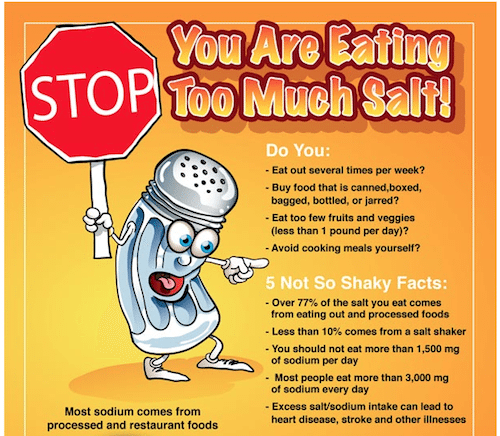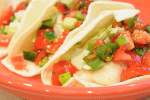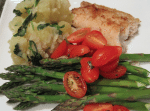Slow Down Your Sodium Intake!
 The Center for Disease Control (CDC) recently published a report revealing that more than 90% of all Americans consume too much sodium, and that 90% of sodium intake comes from retail stores and restaurants (1). The Dietary Guidelines for Americans also insist that "Americans currently consume too much sodium" (2), counseling people to consume no more than 1500-2300 mg of sodium per day (3). People currently consume an average of 3300 mg of sodium per day (4), which is WAY over the healthful limit. So where exactly is this sodium coming from? Check out the stats below...
The Center for Disease Control (CDC) recently published a report revealing that more than 90% of all Americans consume too much sodium, and that 90% of sodium intake comes from retail stores and restaurants (1). The Dietary Guidelines for Americans also insist that "Americans currently consume too much sodium" (2), counseling people to consume no more than 1500-2300 mg of sodium per day (3). People currently consume an average of 3300 mg of sodium per day (4), which is WAY over the healthful limit. So where exactly is this sodium coming from? Check out the stats below...
- 36.9% of average sodium consumed came from grains, and these included highly processed foods like bread, frozen meals, and soups (5).
- 27.9% of average sodium consumed came from meats, poultry, fish, and mixtures; most of this is from processed meats and fried items (6).
- 12.4% of average sodium consumed came from vegetables (7). Vegetables are naturally low in sodium, but this category does include processed versions that come in cans or with prepared sauces.
Reduce Sodium Intake
 Did you know that excess sodium intake kills more Americans than tobacco? Plus, it's the number one reason that older individuals are checked into a nursing home for life. How can you combat high sodium intake? One of the steps that makes the biggest difference is cooking food at home from scratch. Then you can determine exactly how much salt goes into a given dish. Plus, it's cheaper! You can also make adjustments to the way you prepare grains and use fresh herbs. How? We discuss each of these options in more detail below...
Did you know that excess sodium intake kills more Americans than tobacco? Plus, it's the number one reason that older individuals are checked into a nursing home for life. How can you combat high sodium intake? One of the steps that makes the biggest difference is cooking food at home from scratch. Then you can determine exactly how much salt goes into a given dish. Plus, it's cheaper! You can also make adjustments to the way you prepare grains and use fresh herbs. How? We discuss each of these options in more detail below...
Focus on Grains
 Grains make up almost half of excess sodium intake. Here are 3 grain-based dishes that you can adjust in order to reduce sodium consumption.
Grains make up almost half of excess sodium intake. Here are 3 grain-based dishes that you can adjust in order to reduce sodium consumption.
- Boxed rice - make your own flavored rice -- you'll save money and sodium. Combine 1 cup brown rice, 2 cups water, 1 teaspoon garlic powder, black pepper, and paprika to taste, then prepare according to package directions. For a treat, fold in fresh chopped parsley and a squeeze of lemon once the rice is cooked. For every cup of rice that you prepare in this manner, you will save 600-900 mg of sodium, compared to boxed rice mix.
- Pizza - if you make your own crust, use pitas without salt or buy pre-made pizza crusts that are low in sodium. You can also top the pizza with sauce that contains no added salt. Be sure to go light on the cheese too. One slice of store or restaurant pizza contains 600 mg of sodium -- your at-home solution will have much less.
- Pasta - instead of using sauce from cans or mixes from boxes, get creative and cook the pasta yourself! You can top pasta with fresh veggies that are lightly cooked in olive oil or roasted in the oven. You could also use no-added salt tomato sauce or steamed veggies. Top your creation with fresh basil or parsley instead of cheese. For every cup of frozen, canned, or restaurant pasta you skip, you will save about 600- 1000 mg of sodium.
Choose Fresh Herbs
 Fresh herbs are a great way to add flavor to meals without increasing the sodium content. At this time of year, it is especially easy to track down fun new fresh herbs. Experiment until you find flavor combinations that work for you. You can even grow herbs at home!
Fresh herbs are a great way to add flavor to meals without increasing the sodium content. At this time of year, it is especially easy to track down fun new fresh herbs. Experiment until you find flavor combinations that work for you. You can even grow herbs at home!
- Add freshly chopped herbs to pasta or rice dishes right before serving.
- Chop a bit of basil, oregano, and rosemary and add them to a dish with a little olive oil and balsamic vinegar for a great bread or veggie dip.
- If you buy more herbs than you can use, chop the extras and freeze them for later.
- A chiffonade of basil adds a refreshing twist to almost all summer drinks.
References
- http://www.cdc.gov/VitalSigns/Sodium/
- http://www.health.gov/dietaryguidelines/dga2010/DietaryGuidelines2010.pdf, page ix
- http://www.health.gov/dietaryguidelines/dga2010/DietaryGuidelines2010.pdf, page x
- http://www.cdc.gov/VitalSigns/Sodium/
- Sodium Intake Among Adults --- United States, 2005?2006; Weekly; June 25, 2010 / 59(24);746-749.
- Sodium Intake Among Adults --- United States, 2005?2006; Weekly; June 25, 2010 / 59(24);746-749.
- Sodium Intake Among Adults --- United States, 2005?2006; Weekly; June 25, 2010 / 59(24);746-749.
More Resources
This post is brought to you by The Nutrition Education Store. Check out our wide selection of helpful posters, handouts, presentations, games, and more!
